Stamped Concrete in Portland Oregon – Is it a Good Idea?
A comparison between stamped concrete with other available hardscape options.
Stamped Concrete vs. Traditional Concrete
Stamped concrete has some distinct advantages when compared to traditional concrete. The main advantage with stamped concrete is the wide availability of colors and patterns. To be sure, stamped concrete usually looks a lot more aesthetically appealing than traditional brushed or exposed aggregate concrete. If you’re 100% sold on concrete for your driveway, pathway, walkway or patio, then stamped concrete is a nicer choice than traditional concrete. The cost is typically about 200% of what regular concrete costs. But the look is worth the additional price. So as far as concrete goes, stamped is a much nicer way to go.
Unfortunately, all concrete cracks over time. It’s inevitable. Concrete, by nature, is imperfect. And over time it’s prone to cracking. The only question is how soon and how badly will it crack. Which leads us to our next topic;
Stamped Concrete vs. Interlocking Pavers
When compared with interlocking concrete pavers, stamped concrete begins to lose the battle. If installed properly, there are almost no disadvantages with pavers. But in comparison, there are a lot of challenges with stamped concrete. Below we’ve outlined a comparison of the two.
Cracking
As mentioned before, stamped concrete cracks. Pavers do not. Even if a concrete paver ever ever did crack, it’s simple to remove the affected paver and install a new one. The same is not possible with stamped concrete. A good friend once put it this way, “There are two kinds of concrete; Cracked Concrete and Gonna Crack Concrete”. Unfortunately, that’s been our experience too. Be sure to read the Lawn & Landscape article to the right regarding the benefits of pavers over concrete and stamped concrete —->
This is the first and biggest disadvantage to stamped concrete when compared to pavers – cracking. Note the cracks in stamped concrete in the following photos:
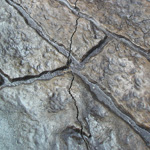
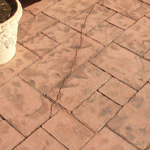
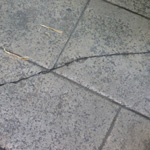
Unsightly Control Joints
All concrete patios, driveways or pathways need control joints. These are the big, deep lines that are installed every 5 or 10 feet on every concrete job. They are installed in an effort to prevent cracking or more specifically, to give the concrete a specific place to crack. The problem with control joints in stamped concrete is they totally ruin the facade that the stamped concrete was trying to accomplish. When you’re trying to make something look like tile or pavers or flagstone, a big gaping line going across the middle sort of ruins that look. With pavers, you never have that problem. Pavers naturally have joints everywhere. The look is preserved all the way through the patio or pathway with pavers. That is not true with stamped concrete. Look at these photos and judge for yourself.
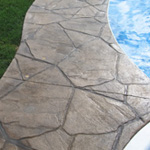
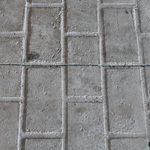
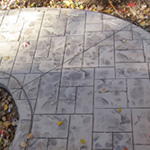
Future Changes / Additions
With stamped concrete, what you get is permanent. If you add on in the future, it won’t ever match up to the first batch that was installed years before. And there is no way to move or change stamped concrete. With pavers, you can change the shape, add more pavers, add a matching pathway, make the patio larger, whatever you want! Pavers are versatile, re-useable, and easy to add on to.
Repairs
Suppose a tree root goes underneath your patio in a few years and causes the patio to raise up and crack. Or suppose for some reason there was some settling or sinking in the patio. With stamped concrete, the damage is permanent. There will be no way to fix the problem. But with pavers, you can easily dig up that area, fix the problem and re-install the pavers to look just like new again!
Slippery When Wet
Many stamped concrete patterns form the concrete into a smooth pattern on top. While this is pleasing in the summer, you’d better watch out when it rains! Stamped concrete is often very slippery when wet. Some stamped concrete contractors even install a scratch coat or sand coat into the surface to help mitigate this problem. But most do not. And they surely won’t tell you how you’ll be sliding around your patio or driveway if you ever have to walk or drive on it in the winter. This is not an issue with pavers. Pavers have a surface that is just perfect for traffic. Smooth enough to look and feel nice. But sturdy enough to have some grip in the rain.
Durability, Stability, Dependability
If built to standards, Concrete Pavers have a compressive strength of 8,000-10,000 PSI or more. Whereas the compressive strength of concrete is typically only 3000-4000 PSI. That means pavers have a greater weight bearing capacity than concrete does. Which is important for any surface but particularly reassuring for your driveway.
Comparable in Cost
Sometimes pavers can add up to a slightly higher price tag. But Pavers are only slightly higher priced, per square foot, as stamped concrete. Given that pavers are custom built and each piece is set in by hand, the overall value is much greater for pavers vs. stamped concrete.
Curing Time / Curing Problems
You can walk or drive on pavers the instant the job is finished. This is not true with concrete. There is typically a curing time of 3-5 days before you can use concrete after it’s been installed. And although you may not be in that much of a rush, problems can arise during that curing time, such as inclement weather, children or animals running across the concrete, vandals writing in the concrete before it cures, or dramatic changes in temperature overnight that can cause the concrete to cure at different rates throughout the job. None of this is a concern, with pavers. They’re fixed and ready to go from the moment the job is done!
Recycling Issues
Any concrete contractor worth his salt will install rebar into the concrete during construction. The downside of this is if the concrete is ever torn out and removed in the future, the recycling centers will not accept concrete with rebar inside of it. So the used concrete ends up in a landfill. Pavers are individual units. And you can recycle them in two different ways. First (hopefully) you would just find someone who wants them. But if that’s not an option for some reason, you can fully recycle the pavers at any plant that accepts clean used concrete.
Variety / Selection
The average stamped concrete contractor will have maybe 5-15 different stamps available. Whereas the average paver contractor will often have half a dozen different paver suppliers each with a dozen or so paver varieties and several color options in each variety. The options available in pavers massively outweigh those in the stamped concrete market.
Imitation? Or the Real Thing?
Stamped concrete, by nature, is an imitation of something else. The stamp and coloring is typically trying to mimic either tile, brick, pavers, blue stone, or flagstone. Given the similarity in cost, why wouldn’t you just go for the real thing? Concrete pavers come in all sorts of shapes and sizes, from flagstone to large tile to real cut stone to concrete interlocking pavers. If that’s the look you’re after, why not get the real thing?
We’ve made a decision here at Lewis Landscape Services to not install stamped concrete for all of the reasons above. There is almost no benefit to stamped concrete over pavers. The variety available in pavers these days is better than anything available in the stamped concrete market. Furthermore, we warranty all of our work for 5 years. Concrete is something we cannot warranty. We know it will probably crack in the first 5 years and there’s little we can do to prevent that. This is why you’ll probably never find a stamped concrete contractor that will warranty their work against cracking. And if you do, you’ll probably never find one that will offer a warranty that is greater than 1 year. There’s a reason for this. Stamped concrete looks nice when compared to regular, traditional concrete. But the better option is pavers. Please review our page on interlocking concrete pavers. And call today to see some samples of what we could do for your property!
Lewis Landscape Services – Paver Patios & Driveways Portland Oregon Page
For All Your Landscaping Needs
- Landscape Design
- Rock Walls
- Segmental Retaining Walls
- Paver Patios & Walks
- Flagstone Patios & Walks
- New Sod Lawns
- Fences & Decks
- Outdoor Lighting
- Irrigation Systems & Repair
- Courtyard Walls
- Clean-Ups
- Weekly Maintenance
- Drainage
- Rock Work
- Barkdust / Mulch
Licensed, Bonded & Insured
LCB #8112 CCB# 231440
Portland Metro Lic.# 9303



